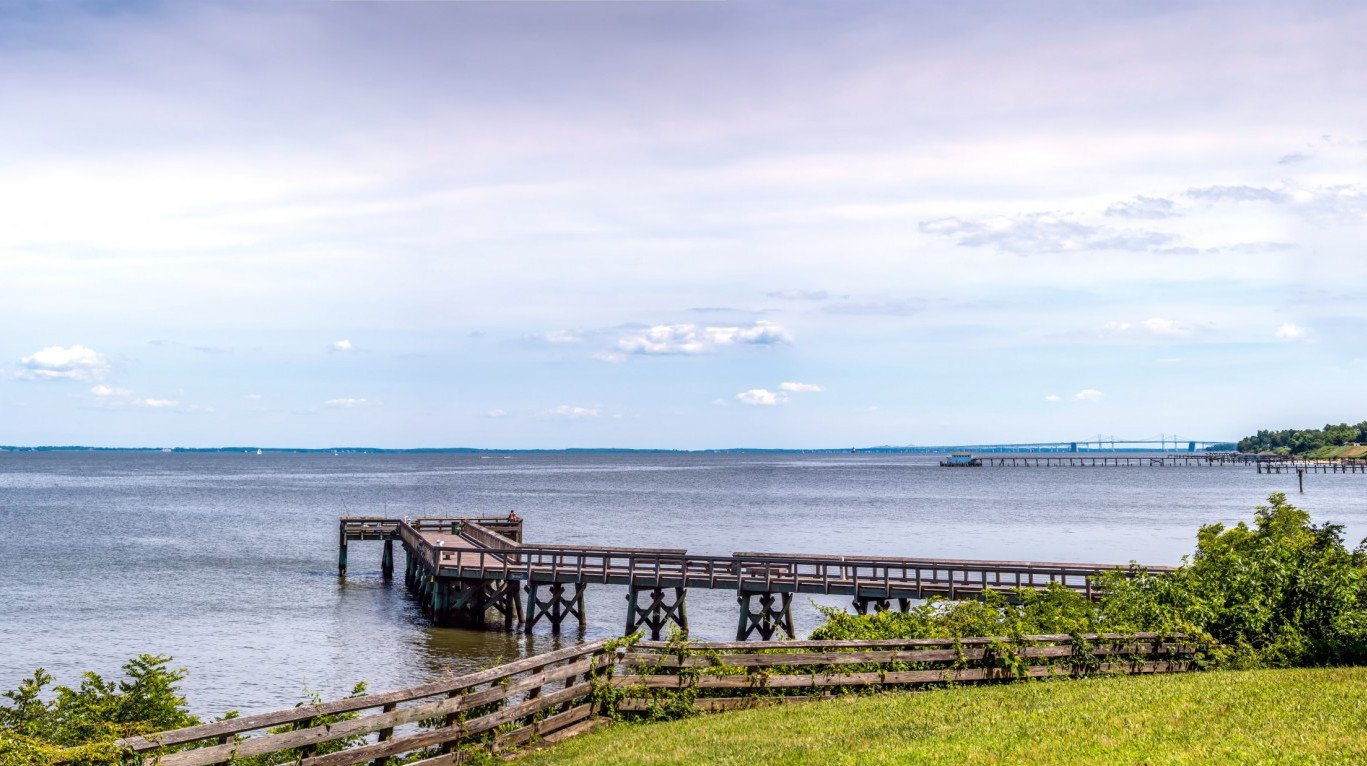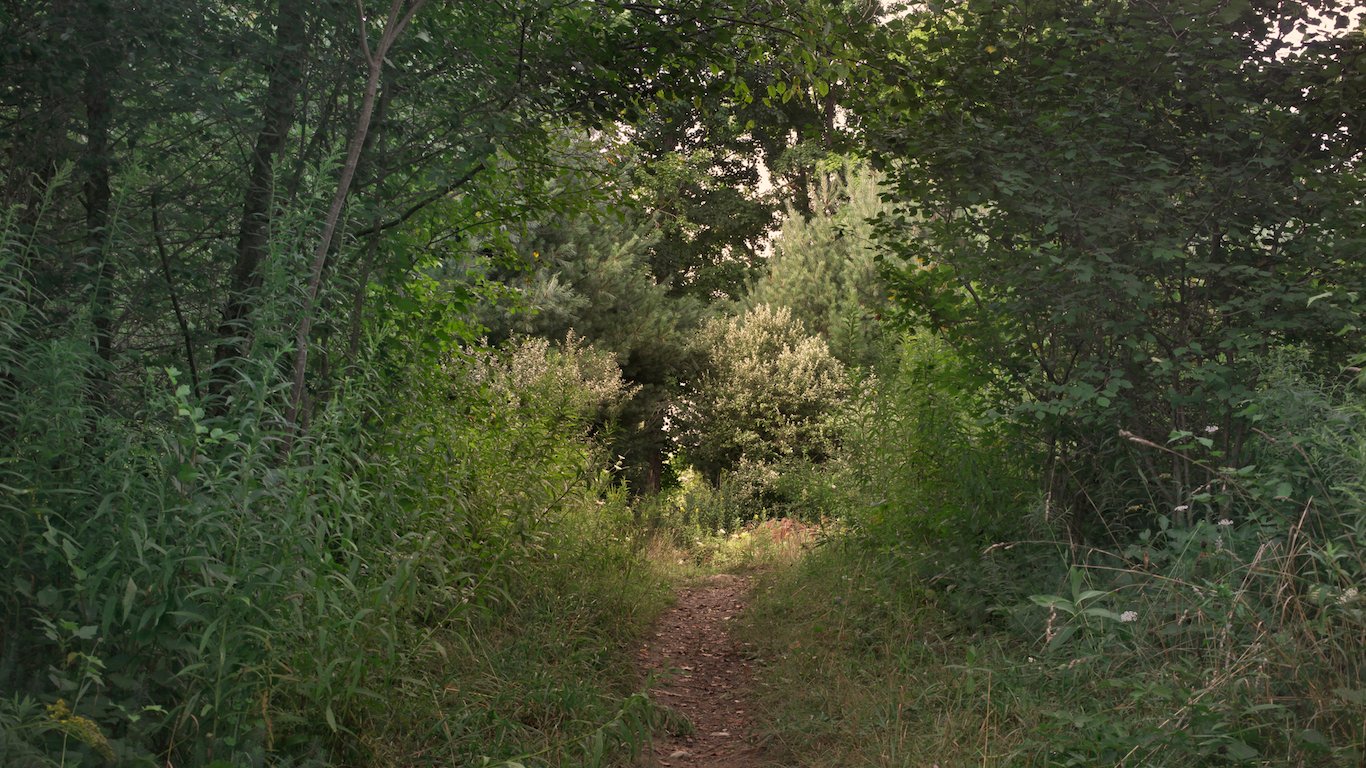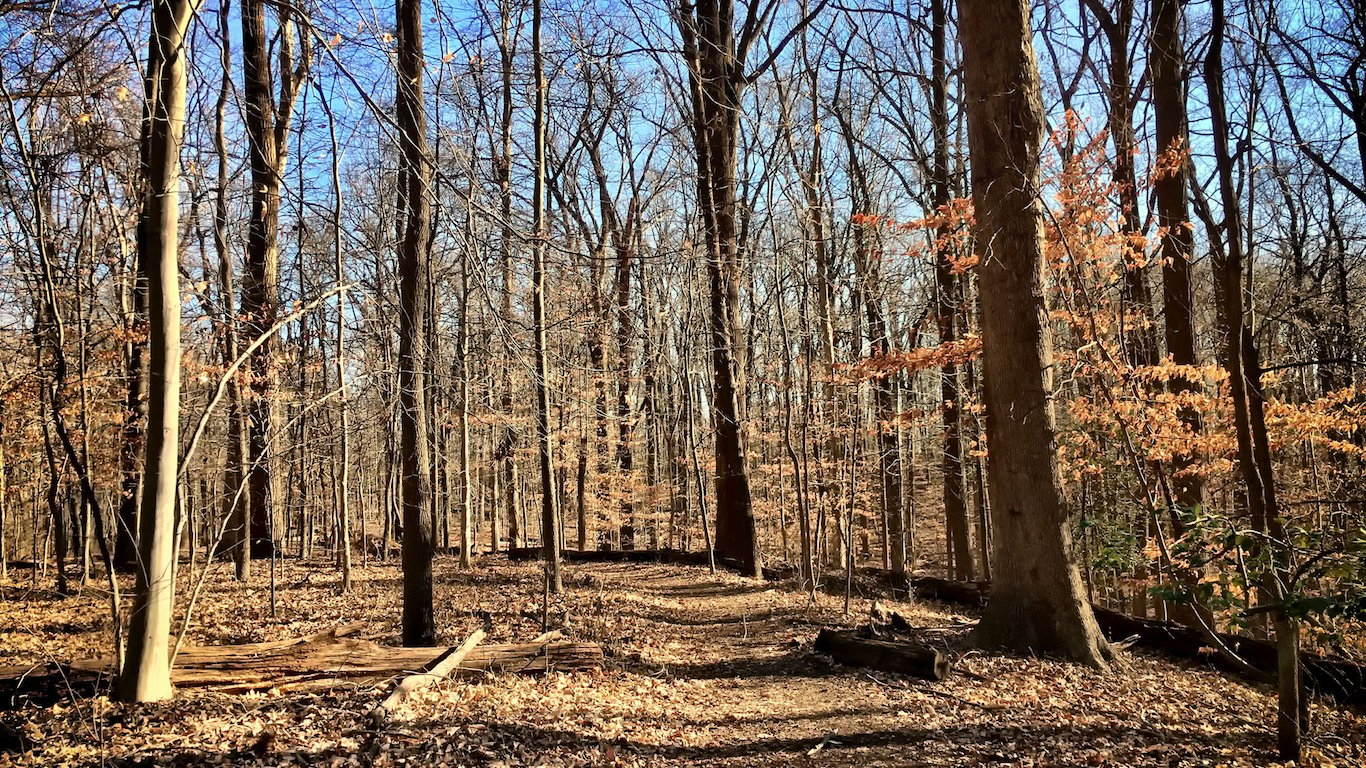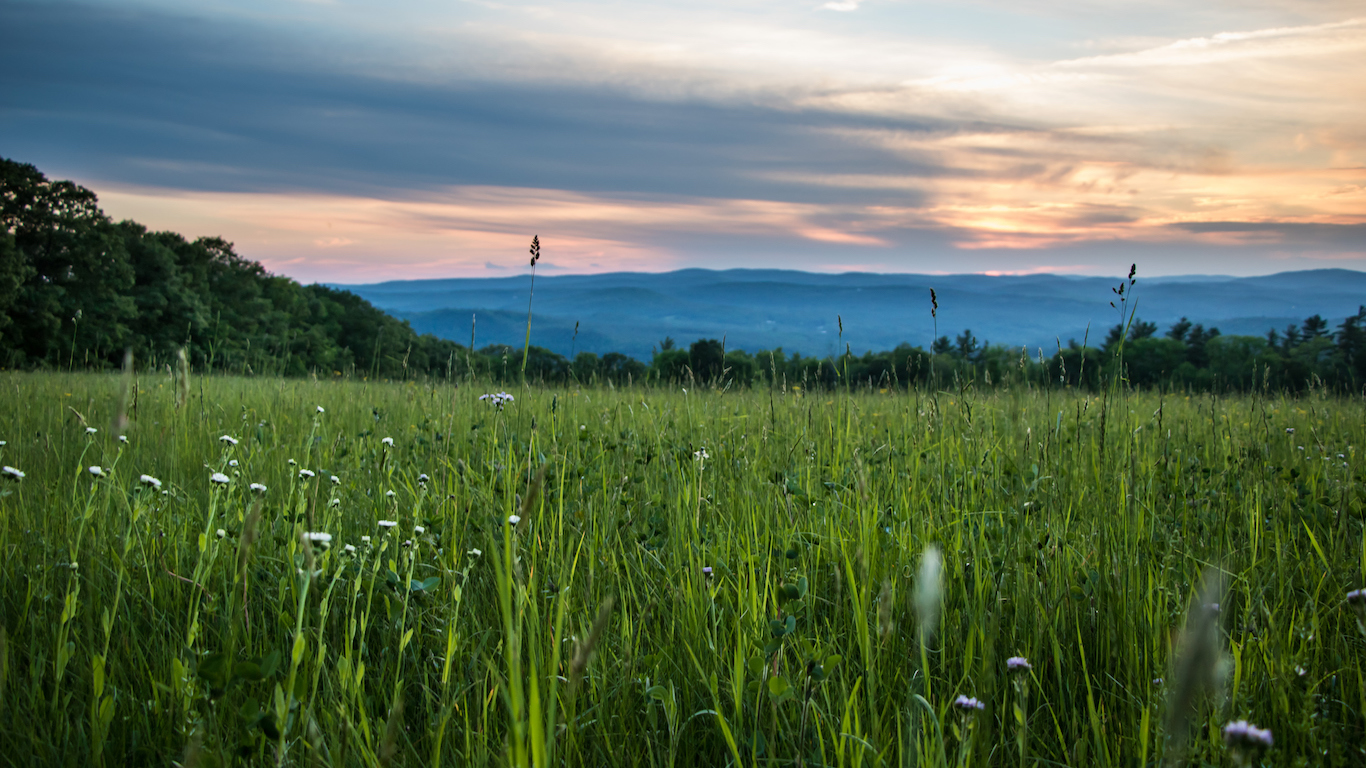
Lyme disease is a debilitating, sometimes fatal infection passed to humans by infected blacklegged ticks. According to the Centers for Disease Control and Prevention, there are more than 30,000 cases of the disease each year nationwide. Due to underreporting, the actual incidence may be as high as 10 times the reported figure.
Lyme disease has been reported in every state except Hawaii at least once since 2005. However, the disease tends to be heavily concentrated in certain parts of the country. About 86% of confirmed cases of Lyme disease in the United States were reported in the 12 states on this list — which are largely concentrated in the Northeast and mid-Atlantic regions.
24/7 Wall St. reviewed CDC data on confirmed cases of the disease to determine the worst states in the country for Lyme disease.
Almost anyone who spends time outdoors — whether in backyards, gardens, forests, or hiking trails — is at risk of getting bitten by an infected tick. States with higher rates of Lyme disease often have more physically active adult populations and relatively large rural populations.
Editor’s note: Due to a fact-checking error, Windham County, Connecticut was incorrectly listed as being located in the northwest corner of the state. In Fact, it is in the northeast corner of the state. This error has been corrected.
Click here to see the 12 worst states for Lyme disease.
Click here to see our detailed findings and methodology.

Source: Thinkstock
12. New York
> Incidence of Lyme disease: 16.4 per 100,000 residents
> Confirmed cases: 3,252 (3rd highest)
> Pct. population rural: 12.1% (12th lowest)
> Pct. adults physically active: 76.0% (15th lowest)
Northeastern states tend to have more cases of Lyme disease than other parts of the country — and New York state is no exception. There were 3,252 confirmed cases in New York in 2015, or 11.4% of all Lyme diagnoses nationwide that year. Blacklegged ticks, the tick species that carries Lyme, are typically found in tall grass and brush along the edge of forests — and partially as a result Lyme infected ticks are relatively rare in New York City and far more common in the less densely populated areas upstate.
Though the number of cases in New York is down considerably from a 10-year high of 5,741 in 2008, experts predict a spike in Lyme disease cases this summer. The blacklegged ticks that carry the disease often use mice as hosts, and because of a bumper crop of acorns in 2015, the number of mice is projected to increase. This, in turn, will likely support a larger tick population.
[in-text-ad]

Source: Thinkstock
11. Maryland
> Incidence of Lyme disease: 20.8 per 100,000 residents
> Confirmed cases: 1,249 (7th highest)
> Pct. population rural: 12.8% (13th lowest)
> Pct. adults physically active: 78.5% (23rd highest)
There were 1,249 confirmed cases of Lyme disease in Maryland in 2015, the most in the state since 2009, when there were 1,466 diagnoses. The blacklegged tick, which carries Lyme disease, is typically found in heavily wooded areas or in grassy areas such as parks and backyards. While 87.2% of Maryland residents live in urban environments that are largely inhospitable to ticks, 93.4% of people in the state have access to places for recreation, including public parks and hiking trails.
Many experts believe this year could be the worst in recent memory for Lyme disease in the state. The unusually warm winter and wet spring in early 2017 may lead to an explosion in the tick population — which would likely cause a spike in the incidence of Lyme infections.

Source: Thinkstock
10. Minnesota
> Incidence of Lyme disease: 21.4 per 100,000 residents
> Confirmed cases: 1,174 (8th highest)
> Pct. population rural: 26.7% (25th highest)
> Pct. adults physically active: 81.3% (10th highest)
The CDC identifies the upper Midwest as a high risk Lyme disease area. There were 21.4 confirmed cases of Lyme disease for every 100,000 people in Minnesota in 2015, the most of any state in the region and the 10th highest rate of all states.
Ticks are often found in heavily wooded areas, which are relatively common in Minnesota. More than one in four state residents live in rural areas, and over 81% of adults in Minnesota report regular physical activity — each far greater than the corresponding national shares. As is the case in many states, Minnesota residents may be at greater than usual risk of Lyme disease in 2017 as the mild winter has allowed the tick population to flourish.

Source: AlexiusHoratius / Wikimedia Commons
9. New Hampshire
> Incidence of Lyme disease: 32.8 per 100,000 residents
> Confirmed cases: 436 (13th highest)
> Pct. population rural: 39.7% (11th highest)
> Pct. adults physically active: 80.1% (13th highest)
Though it has the lowest Lyme disease incidence rate in New England, New Hampshire has one of the highest incidences of Lyme disease of all states. There were 32.8 confirmed cases for every 100,000 people in the state in 2015, more than triple the national rate.
The 436 confirmed cases in 2015 marks a considerable improvement from 2013, when there were 1,324 confirmed cases of Lyme disease. That year, New Hampshire had the second highest incidence of Lyme disease. Changes in incidence can be attributed to a host of factors, including year to year weather variations, the presence of certain animals that host disease carrying ticks, and reporting habits.
[in-text-ad]

Source: https://www.flickr.com/photos/jb912/
8. Delaware
> Incidence of Lyme disease: 35.3 per 100,000 residents
> Confirmed cases: 334 (14th highest)
> Pct. population rural: 16.7% (17th lowest)
> Pct. adults physically active: 75.9% (13th lowest)
Delaware had the highest incidence of Lyme disease of all states in four of the 10 years through 2015. Based on the latest data from 2015, the mid-Atlantic state ranks eighth, with 35.3 confirmed cases for every 100,000 residents — well below the state’s 10-year high of 111.2 cases per 100,000 people in 2009. Lyme disease cases were heavily concentrated in New Castle, the northernmost county in the state, along the Maryland and Pennsylvania state borders.
Epidemiologist Bradley Tomkins said in an interview that improving Lyme disease education and awareness remains one of the best ways to reduce the incidence of the disease. Last year, the Delaware legislature passed House Bill 291, which encourages medical professionals to continue their education of the disease. The bill also includes provisions for a multi-platform public awareness campaign.

Source: Thinkstock
7. Massachusetts
> Incidence of Lyme disease: 43.0 per 100,000 residents
> Confirmed cases: 2,922 (4th highest)
> Pct. population rural: 8.0% (4th lowest)
> Pct. adults physically active: 79.7% (16th highest)
About one in every 10 confirmed cases of Lyme disease in the United States are diagnosed in Massachusetts. There were 2,922 confirmed cases of the disease in the state in 2015 as well as another 1,302 probable cases. As was the case nationwide, 2009 was the worst year for Lyme in recent memory in Massachusetts, with 4,019 confirmed cases, or 61 for every 100,000 people.
The highest incidence rates in Massachusetts in recent years have been in towns in the southwest corner of the state along the border with New York and Connecticut, as well as in towns on Cape Cod, Martha’s Vineyard, and Nantucket. All of these areas are relatively green and hospitable for blacklegged ticks. In contrast, Boston, the largest city in New England, has one of the lowest Lyme disease incidence rates in the state.

Source: Wikimedia Commons
6. New Jersey
> Incidence of Lyme disease: 43.9 per 100,000 residents
> Confirmed cases: 3,932 (2nd highest)
> Pct. population rural: 5.3% (2nd lowest)
> Pct. adults physically active: 77.1% (22nd lowest)
There were 3,932 confirmed cases of Lyme disease in New Jersey in 2015 and another 923 probable cases — up considerably from the 2,589 confirmed cases the previous year. As was the case nationwide, Lyme disease rates in New Jersey hit a 10-year high in 2009, when there were 4,598 diagnoses.
While New Jersey is a largely urban state, 94.5% of Garden State residents have access to locations for physical activity, including parks and hiking trails that can often be suitable habitats for ticks.
[in-text-ad]

Source: Thinkstock
5. Connecticut
> Incidence of Lyme disease: 52.2 per 100,000 residents
> Confirmed cases: 1,873 (5th highest)
> Pct. population rural: 12.0% (11th lowest)
> Pct. adults physically active: 79.7% (15th highest)
Lyme disease derives its name from Lyme, Connecticut — a town where, in 1975, a number of residents reported unusual arthritic symptoms. The bacteria that caused the disease was identified in 1982, and five years later, Lyme was designated a disease of great public importance. Lyme disease remains a major concern in the state, infecting about 52 people in 100,000 in 2015, nearly six times the nationwide incidence.
Lyme cases in Connecticut spike in June and July, affecting adults between the ages of 60 and 69 more than any other age group. Windham County, in the northeast corner of the state along the border with Massachusetts and Rhode Island, has the highest Lyme disease rate in the state.

Source: John Phelan / Wikimedia Commons
4. Rhode Island
> Incidence of Lyme disease: 53.4 per 100,000 residents
> Confirmed cases: 564 (11th highest)
> Pct. population rural: 9.3% (7th lowest)
> Pct. adults physically active: 77.1% (24th lowest)
Every state in New England is on this list. The incidence of Lyme is higher in Rhode Island than in all but three other states, including neighboring Connecticut and Massachusetts. There were 53.4 confirmed cases of Lyme for every 100,000 people in the state in 2015, not factoring in the 340 probable cases of the illness.
Partially because Lyme disease is such a concern in the state and the region, Rhode Island is home to a number of facilities that specialize in diagnosing and treating the disease, including Lyme Center of New England and the Lifespan Lyme Disease Center at Newport Hospital.

Source: Thinkstock
3. Pennsylvania
> Incidence of Lyme disease: 57.4 per 100,000 residents
> Confirmed cases: 7,351 (the highest)
> Pct. population rural: 21.3% (19th lowest)
> Pct. adults physically active: 76.9% (19th lowest)
There were 7,351 confirmed cases of Lyme disease in Pennsylvania in 2015 — far more than any other state and accounting for 25.8% of cases nationwide. Both the number of cases and the incidence rate of 57.4 diagnoses per 100,000 residents made 2015 the worst year for Lyme in the Keystone State in at least a decade.
In light of the prevalence of Lyme disease in the state, Pennsylvania lawmakers are currently considering House Bill 174, which would require health insurance providers to cover prescribed treatment for Lyme disease — including longer-term treatments that may be necessary for some patients.
[in-text-ad]

Source: Thinkstock
2. Maine
> Incidence of Lyme disease: 74.7 per 100,000 residents
> Confirmed cases: 993 (10th highest)
> Pct. population rural: 61.3% (the highest)
> Pct. adults physically active: 79.8% (14th highest)
There were 74.7 confirmed cases of Lyme disease for every 100,000 Maine residents in 2015, the second highest rate in New England and the country. Ticks are often found in wooded areas, and 61.3% of Maine’s population resides in rural parts of the state — the largest share in the country.
Knox County, which is situated along the Atlantic coastline just north of Portland, reports the highest incidence rate of Lyme in Maine. The incidence rate in Knox is followed closely by the reported cases in bordering counties of Lincoln and Waldo and nearby Hancock County.

Source: Thinkstock
1. Vermont
> Incidence of Lyme disease: 78.4 per 100,000 residents
> Confirmed cases: 491 (12th highest)
> Pct. population rural: 61.1% (2nd highest)
> Pct. adults physically active: 81.5% (6th highest)
Vermont is one of the most rural states with one of the most physically active populations. Some 61.1% of the Green Mountain State’s population lives in rural areas, and 81.5% of Vermont adults lead active lifestyles, the second and sixth largest shares of any U.S. state, respectively. In addition, blacklegged ticks thrive throughout the state, adding to conditions that together contribute to an especially high Lyme disease incidence rate. There were 78.4 confirmed cases of the disease for every 100,000 state residents in 2015, the highest rate of any state and nearly nine times the national rate.
In keeping with the broader national trend, the incidence of Lyme disease is on the rise in Vermont. The 491 confirmed cases of Lyme in the state in 2015 was up from only 54 in 2005.
Detailed Findings and Methodology
Environmental conditions play a critical role. In an interview with 24/7 Wall St., Bradley Tompkins, vector-borne epidemiologist with the Vermont Department of Health, explained that in order for Lyme disease to persist in a community three conditions are necessary: 1) the pathogens that cause Lyme disease; 2) the ticks that can spread it; 3) and the animals to host the ticks, which include a variety of shrew, mouse, and deer.
“It so happens that up here in the northeastern United States, we have those three things together,” Tomkins said. The Northeast, mid-Atlantic, and upper Midwest contain all of the states with the highest incidence rates of Lyme disease.
The infection is often hard to detect as blacklegged ticks can be hard to see, ranging from three to five millimeters in length. Additionally, symptoms vary from patient to patient, though most exhibit a rash resembling a bull’s-eye target. Other common symptoms include headaches, neck stiffness, muscle and joint pain, dizziness, and irregular heart beat.
Even in patients exhibiting such symptoms, the disease can be hard to diagnose. Tompkins explained that the Lyme disease test sanctioned by the Food and Drug Administration checks for the presence of a certain antibody. However, because the human body does not produce the antibody response in the first few weeks of the illness, the test can return with a negative diagnosis if administered too early.
In most cases, treating Lyme disease is relatively simple. If caught early enough, most patients recover quickly and completely with a regimen of oral antibiotics. In rarer cases, commonly referred to as chronic Lyme disease, symptoms can persist for six months or more.
Because of the many pre-conditions needed to spread Lyme disease, incidence rates can fluctuate considerably year to year. Experts use several factors to predict how severe a given year will be, Tompkins explained, including: “How big is the mouse population? What was the winter weather like? How dry and hot it is during the summer?” However, despite yearly fluctuations, he added, the number reported cases appears to be steadily on the rise.
The unique nature of Lyme disease limits the options state and local governments have at their disposal to reduce incidence rates. “Unlike a lot of other infectious diseases that we work on at Health Department that might have a vaccine […] with these tick-borne diseases really the only tool in the public health toolbox is education and awareness,” Tompkins said. Several states on this list are taking active legislative measures to promote Lyme disease awareness and improve patient treatment options.
In order to determine the 12 worst states for Lyme disease, 24/7 Wall St. reviewed CDC data on the number of confirmed cases in each state for every 100,000 residents in 2015. States were ranked in order from the lowest incidences to the highest. We also reviewed the total number of confirmed cases, along with the incidence rate, for each of the previous 11 years. The number of probable cases in 2015 also came from the CDC. Supplemental data, including the percent of physically active adults, percentage of each state’s population with access to places for physical activity, and the percentage of the population living in rural areas are for 2016 and came from County Health Rankings & Roadmaps, a Robert Wood Johnson Foundation and University of Wisconsin Population Health Institute joint program.
Sponsored: Want to Retire Early? Here’s a Great First Step
Want retirement to come a few years earlier than you’d planned? Or are you ready to retire now, but want an extra set of eyes on your finances?
Now you can speak with up to 3 financial experts in your area for FREE. By simply clicking here you can begin to match with financial professionals who can help you build your plan to retire early. And the best part? The first conversation with them is free.
Click here to match with up to 3 financial pros who would be excited to help you make financial decisions.
Thank you for reading! Have some feedback for us?
Contact the 24/7 Wall St. editorial team.
 24/7 Wall St.
24/7 Wall St. 24/7 Wall St.
24/7 Wall St.
